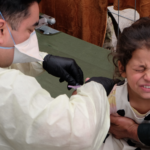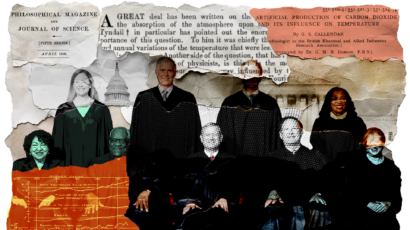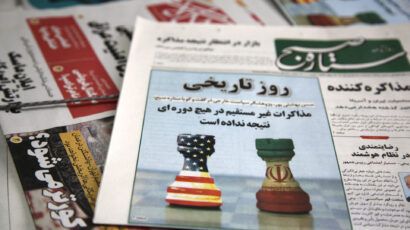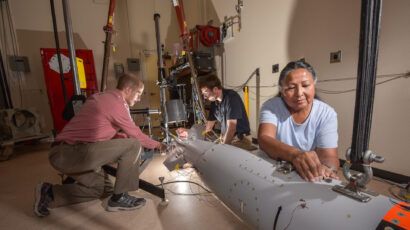Modeling disease spread
By Laura H. Kahn | January 15, 2009
Many things went wrong during Britain’s 2001 foot-and-mouth disease crisis. Initial efforts at identifying infected animals, slaughtering them, and burying their carcasses within 24 hours–the tried-and-true method for containing the disease–were sluggish at best. And the country’s Ministry of Agriculture, Fisheries, and Food (MAFF), still reeling from criticism about how it handled the country’s decade-long mad cow disease epidemic, was unprepared for the severity of the foot-and-mouth outbreak.
Both failings contributed to the assemblage of an ad hoc group of mathematical modelers, who were tasked with helping develop policies to contain the epidemic. Ultimately, they used mathematical models to devise a controversial “contiguous cull” slaughter policy that killed nearly six million animals. (Four million animals were slaughtered for disease-containment purposes, while an additional two million animals were slaughtered because the animals couldn’t be moved to pasture due to movement restriction policies or were no longer marketable.)
The 2001 foot-and-mouth disease outbreak is one of the first cases in which mathematical models were used to develop real-time response policies during an epidemic. Of course, it’s open to debate whether the models helped or hurt the situation.”
The outbreak began sometime in January 2001 at a farm in northeast Britain where the farmers fed their pigs “swill,” or in layperson’s terms, untreated garbage. Swill is supposed to be boiled for four hours to inactivate viruses, but in this case, it wasn’t. The infected pigs excreted virus into the atmosphere, spreading it to seven adjacent farms. One of these farms, Prestwick Hall Farm, is believed to have been responsible for much of the disease’s rapid spread by sending sheep, which were infected but not showing signs of illness, to be sold at a market with 3,800 other sheep and 85 cattle.
Weeks afterward, on February 19, a veterinarian at Cheale’s Abattoir, a slaughterhouse, first detected the outbreak when he discovered distressed pigs with mouth blisters. By this time, at least 57 farms in 16 counties were infected. The government ordered that all livestock markets and slaughterhouses be shut down and banned the export of livestock and animal products.
As additional infected farms were identified, the MAFF minister and Britain’s chief veterinary officer repeatedly assured the press and public that the crisis was “under control.” Obviously, each newly identified case undermined their credibility.
(Some pertinent background on foot-and-mouth disease: Sheep spread it easily because they show minimal signs of illness. Pigs generate large numbers of viral particles and spread the disease through their secretions and excretions, but cows suffer the most from the disease. Young animals often die.)
Peter Jenkins, a member of the public, published a letter in the Times of London with suggestions for an effective government response: “I was brought up on a farm which fell victim to foot-and-mouth in 1961 and 1967. Two points trouble me about the way the current outbreak is being handled. First, I note from my teenage diary of 1967 that a vet confirmed our farm had the disease on the morning of November 8, and that our animals were slaughtered by evening without waiting results of any test, a delay which gives the disease further time to multiply. Secondly, troops moved in on the morning of November 10 to help disinfect and cleanup. In view of the fact that authorities are now losing the logistical battle to dispose of infected animals, isn’t it time to call in the army again? Or would that be a political admission of a crisis out of control?”
Part of the problem was staffing. Since the 1967 outbreak, which Britain contained by slaughtering a relatively small 434,000 pigs, sheep, and cattle, the MAFF had reduced its ranks of state veterinarians by two-thirds and outsourced livestock inspections to private-practice veterinarians. The number of veterinarians practicing large animal medicine had decreased as well. Exacerbating the situation was the fact that the country’s sheep population had increased by almost 60 percent over this same time period.
The shortage of veterinarians became an especially critical factor in 2001 because after a veterinarian and his or her team walked onto an infected farm, they were classified as “dirty” and couldn’t work at another farm until after a specified period of time as they can inadvertently spread the disease on their clothes and shoes. Inanimate objects and vehicles can spread the virus as well. This meant that the number of veterinarians needed to work on infected farms increased dramatically as the number of identified infected farms grew.
Farmers were required to remain isolated in their homes. At least three of them committed suicide during the crisis because they couldn’t cope and were worried about their animals. One farmer complained that carcasses remained on his farm for four days and that the smell was “diabolical.” Another said it took five days for his herd to be slaughtered, which gave the virus plenty of time to spread. With no end in sight, some farmers rioted, demanding that the government get rid of infected livestock more quickly and stop the slaughter of uninfected animals. They also demanded that the army be brought in to help.
On March 15, Prime Minister Tony Blair announced that there would be a massive cull of animals throughout Britain; on March 21, the ad hoc group of mathematical modelers met and concluded that the foot-and-mouth outbreak was out of control. They stressed that there would likely be thousands of new cases and predicted that the outbreak might not peak until early May. Their models suggested that infected animals be slaughtered within 24 hours and that healthy animals on contiguous premises be preemptively slaughtered within 48 hours. This finding formed the basis for the contiguous cull policy.
After the contiguous cull policy was implemented, a group of veterinarians from Devon, a county in the country’s southwestern region, sent a letter to the government denouncing it as needlessly slaughtering thousands of healthy cattle on farms neighboring those with infected herds. Instead, they wanted to save the cattle by keeping them in barns and culling the sheep. They warned that Devon was on the verge of a “civil war.”
Ultimately, the policy changed on April 25, after a calf was found under a pile of slaughtered animals in Devon. Intense media attention on the calf’s well-being led to public outcry that it be allowed to live. Five months later, the last confirmed case of foot-and-mouth disease occurred–221 days after the first identified case. On January 22, 2002, the World Animal Health Organization declared Britain free of foot-and-mouth disease, and two weeks later, all export restrictions were lifted.
The estimated economic losses to Britain’s gross domestic product as a result of the epidemic were 2 billion pounds. Farmers received approximately 1.34 billion pounds for compensation of their lost livestock. Export losses of agricultural products were around 355 million pounds, and auction markets, food processors, and slaughterhouses lost an estimated 170 million pounds. The tourism industry lost 183 million to 218 million pounds.
More salient to this discussion, the 2001 foot-and-mouth disease outbreak is one of the first cases in which mathematical models were used to develop real-time response policies during an epidemic. The policies helped contain the outbreak, but at a high price: Millions of healthy animals were slaughtered. The public’s concern for animal welfare put an end to that strategy. In other words, ethics trumped the policies developed from mathematical models.
Mathematical models now are being used to help plan and prepare for deadly epidemics such as pandemic influenza. Naturally, policy recommendations for epidemics involving humans–where quarantine, isolation, vaccines, and medications would be used would be vastly different than disease containment strategies for animals. Nevertheless, if the public believed that policies, regardless of how they were derived, involving quarantine, isolation, vaccination, and medication administration were unfair, unethical, or unlawful, they would likely revolt.
In a previous column, I discussed some of the challenges in modeling disease spread. For instance, modelers must make assumptions when they input parameters such as the contagiousness of the disease and at-risk populations.
Refining models to improve precision requires additional assumptions. Each added assumption adds complexity to the model, and there is a trade-off between simplicity versus complexity when developing models. Complex models with many assumptions can increase the risk for errors. And since developing mathematical models require making assumptions, there will likely be challenges to their conclusions. (See “Rescinding Community Mitigation Strategies in an Influenza Pandemic” and “Pandemic Influenza, Reopening Schools, and Returning to Work.”)
Indeed, challenges were issued to the models used in the 2001 British crisis. One foot-and-mouth disease virologist went on television to criticize the methods used to develop the contiguous cull policy. (See “Use and Abuse of Mathematical Models: An Illustration from the 2001 Foot-and-Mouth Disease Epidemic in the United Kingdom.”) A subsequent editorial in the Times of London concluded: “[T]he research it seems was wrong, the science outdated, the slaughter unnecessary, the policy unethical, and the strategy ineffective.”
Generally, some expert epidemiologists question the utility of using mathematical models. Michael Osterholm, a public health expert and director of the Center for Infectious Disease Research and Policy at the University of Minnesota’s School of Public Health told me in July: “My primary conclusion about statistical modeling is that we have an unfortunate outbreak of it occurring. In my 33 years of frontline disease surveillance and outbreak investigation (including 47 credit hours of graduate level statistics), I have found most of them to be a major nuisance. Occasionally, a study will come along that actually is based in reality and provides all the caveats that are appropriate. Because almost no lay non-statistician can understand them, the ‘black-box people’ get away with a lot of mumble jumble that means very little when it comes to real life.”
Certainly, Britain’s experience during the 2001 foot-and-mouth disease outbreak should give policy makers pause before contemplating the use of mathematical models during a crisis. Mathematical models are useful research tools, but as Osterholm cautions, in the real world, when time is of the essence, the most important strategy for outbreak containment is a simple, fair, and ethical one that everyone can understand.
Together, we make the world safer.
The Bulletin elevates expert voices above the noise. But as an independent nonprofit organization, our operations depend on the support of readers like you. Help us continue to deliver quality journalism that holds leaders accountable. Your support of our work at any level is important. In return, we promise our coverage will be understandable, influential, vigilant, solution-oriented, and fair-minded. Together we can make a difference.
Topics: Biosecurity, Columnists















